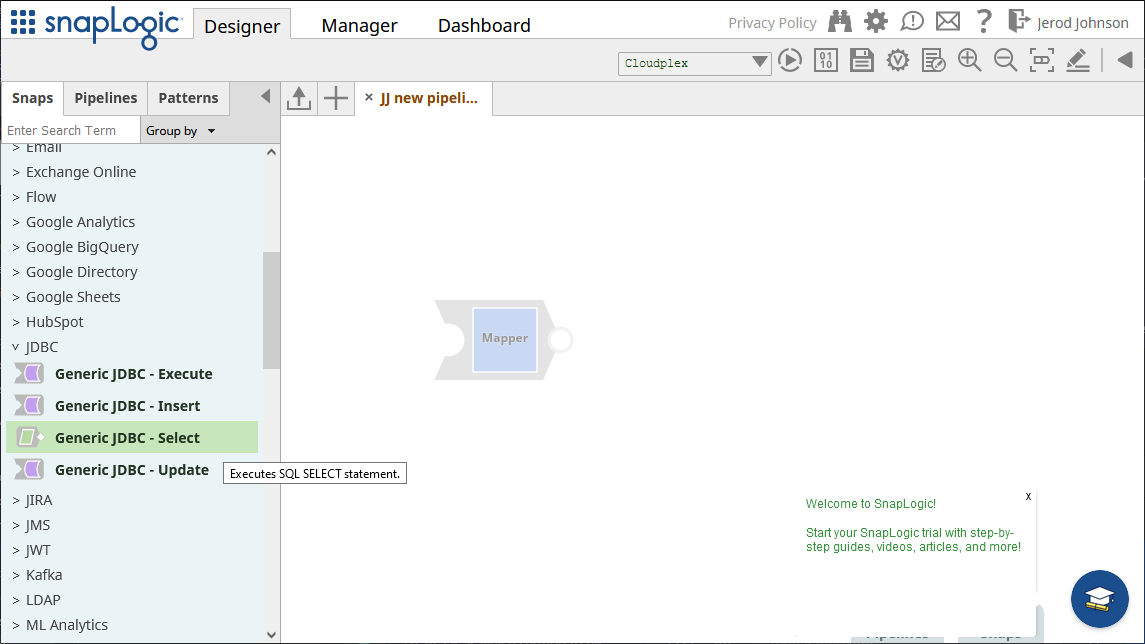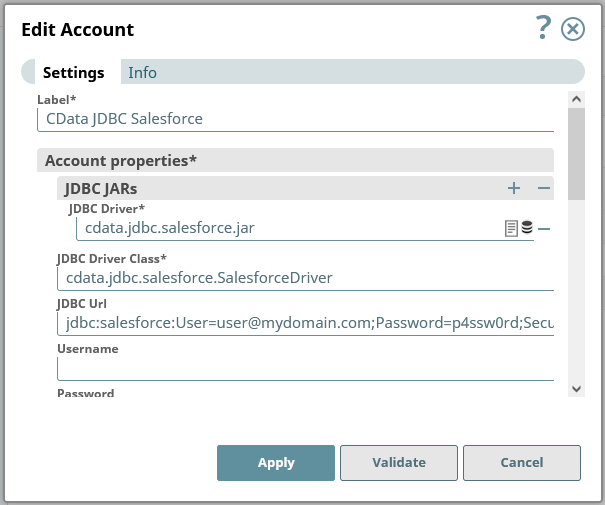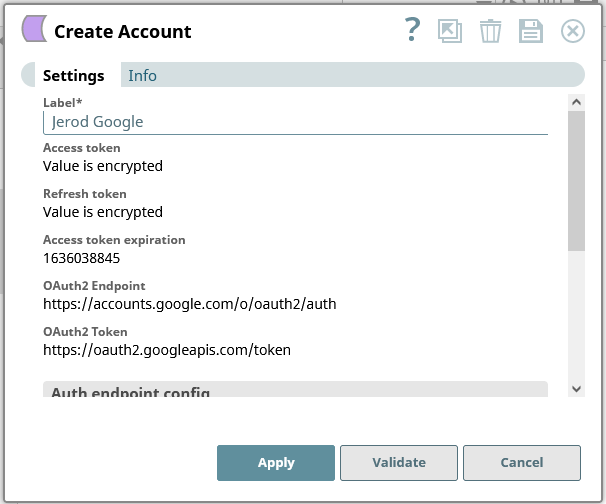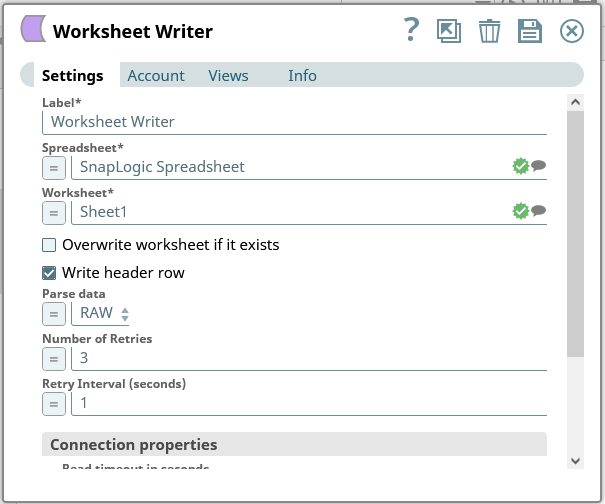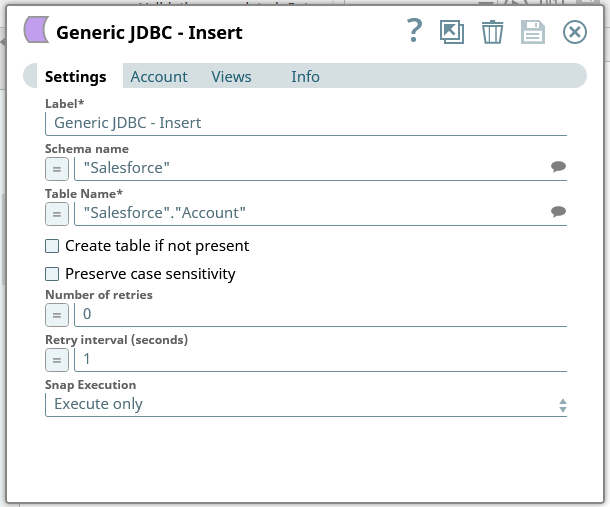Model Context Protocol (MCP) finally gives AI models a way to access the business data needed to make them really useful at work. CData MCP Servers have the depth and performance to make sure AI has access to all of the answers.
Try them now for free →Integrate Elasticsearch with External Services using SnapLogic
Use CData JDBC drivers in SnapLogic to integrate Elasticsearch with External Services.
SnapLogic is an integration platform-as-a-service (iPaaS) that allows users to create data integration flows with no code. When paired with the CData JDBC Drivers, users get access to live data from more than 250+ SaaS, Big Data and NoSQL sources, including Elasticsearch, in their SnapLogic workflows.
With built-in optimized data processing, the CData JDBC Driver offers unmatched performance for interacting with live Elasticsearch data. When platforms issue complex SQL queries to Elasticsearch, the driver pushes supported SQL operations, like filters and aggregations, directly to Elasticsearch and utilizes the embedded SQL engine to process unsupported operations client-side (often SQL functions and JOIN operations). Its built-in dynamic metadata querying lets you work with Elasticsearch data using native data types.
About Elasticsearch Data Integration
Accessing and integrating live data from Elasticsearch has never been easier with CData. Customers rely on CData connectivity to:
- Access both the SQL endpoints and REST endpoints, optimizing connectivity and offering more options when it comes to reading and writing Elasticsearch data.
- Connect to virtually every Elasticsearch instance starting with v2.2 and Open Source Elasticsearch subscriptions.
- Always receive a relevance score for the query results without explicitly requiring the SCORE() function, simplifying access from 3rd party tools and easily seeing how the query results rank in text relevance.
- Search through multiple indices, relying on Elasticsearch to manage and process the query and results instead of the client machine.
Users frequently integrate Elasticsearch data with analytics tools such as Crystal Reports, Power BI, and Excel, and leverage our tools to enable a single, federated access layer to all of their data sources, including Elasticsearch.
For more information on CData's Elasticsearch solutions, check out our Knowledge Base article: CData Elasticsearch Driver Features & Differentiators.
Getting Started
Connect to Elasticsearch in SnapLogic
To connect to Elasticsearch data in SnapLogic, download and install the CData Elasticsearch JDBC Driver. Follow the installation dialog. When the installation is complete, the JAR file can be found in the installation directory (C:/Program Files/CData/CData JDBC Driver for Elasticsearch/lib by default).
Upload the Elasticsearch JDBC Driver
After installation, upload the JDBC JAR file to a location in SnapLogic (for example, projects/Jerod Johnson) from the Manager tab.
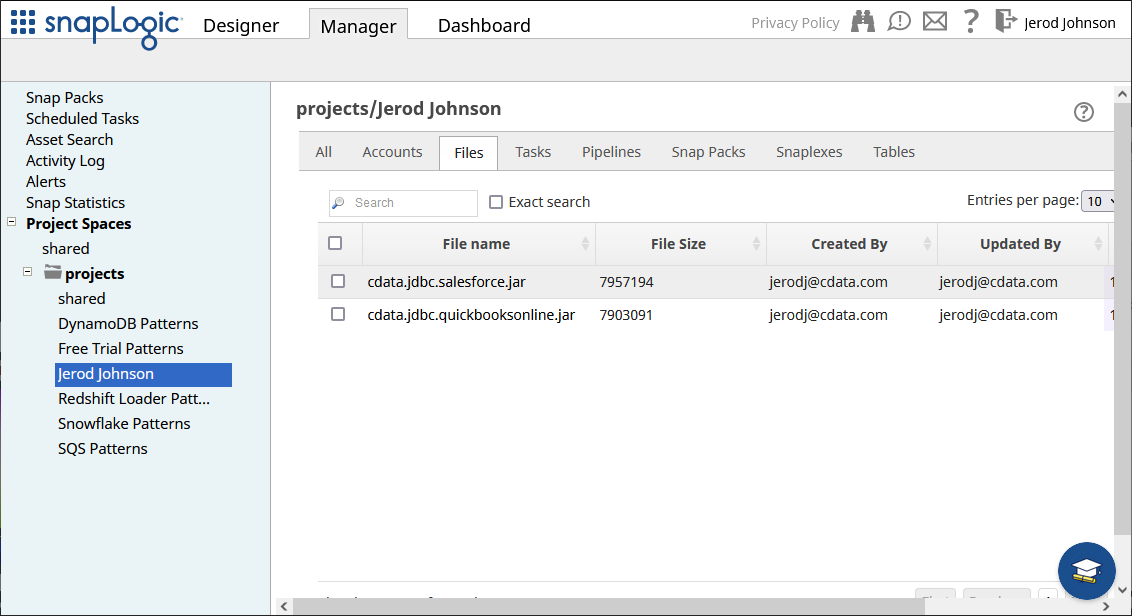
Configure the Connection
Once the JDBC Driver is uploaded, we can create the connection to Elasticsearch.
- Navigate to the Designer tab
- Expand "JDBC" from Snaps and drag a "Generic JDBC - Select" snap onto the designer
![Adding a Generic JDBC snap onto the designer]()
- Click Add Account (or select an existing one) and click "Continue"
- In the next form, configure the JDBC connection properties:
- Under JDBC JARs, add the JAR file we previously uploaded
- Set JDBC Driver Class to cdata.jdbc.elasticsearch.ElasticsearchDriver
Set JDBC URL to a JDBC connection string for the Elasticsearch JDBC Driver, for example:
jdbc:elasticsearch:Server=127.0.0.1;Port=9200;User=admin;Password=123456;RTK=XXXXXX;
NOTE: RTK is a trial or full key. Contact our Support team for more information.
![Configuring a connection (Salesforce is shown)]()
Built-In Connection String Designer
For assistance in constructing the JDBC URL, use the connection string designer built into the Elasticsearch JDBC Driver. Either double-click the JAR file or execute the jar file from the command-line.
java -jar cdata.jdbc.elasticsearch.jar
Fill in the connection properties and copy the connection string to the clipboard.
Set the Server and Port connection properties to connect. To authenticate, set the User and Password properties, PKI (public key infrastructure) properties, or both. To use PKI, set the SSLClientCert, SSLClientCertType, SSLClientCertSubject, and SSLClientCertPassword properties.
The data provider uses X-Pack Security for TLS/SSL and authentication. To connect over TLS/SSL, prefix the Server value with 'https://'. Note: TLS/SSL and client authentication must be enabled on X-Pack to use PKI.
Once the data provider is connected, X-Pack will then perform user authentication and grant role permissions based on the realms you have configured.
![Using the built-in connection string designer to generate a JDBC URL (Salesforce is shown.)]()
- After entering the connection properties, click "Validate" and "Apply"
Read Elasticsearch Data
In the form that opens after validating and applying the connection, configure your query.
- Set Schema name to "Elasticsearch"
- Set Table name to a table for Elasticsearch using the schema name, for example: "Elasticsearch"."Orders" (use the drop-down to see the full list of available tables)
- Add Output fields for each item you wish to work with from the table
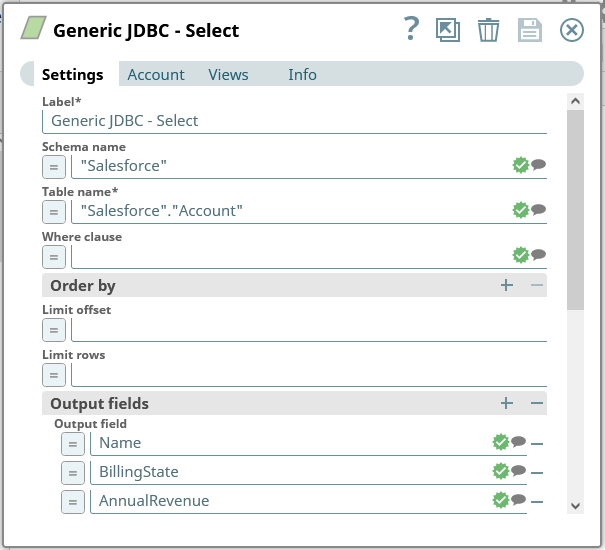
Save the Generic JDBC - Select snap.
With connection and query configured, click the end of the snap to preview the data (highlighted below).

Once you confirm the results are what you expect, you can add additional snaps to funnel your Elasticsearch data to another endpoint.
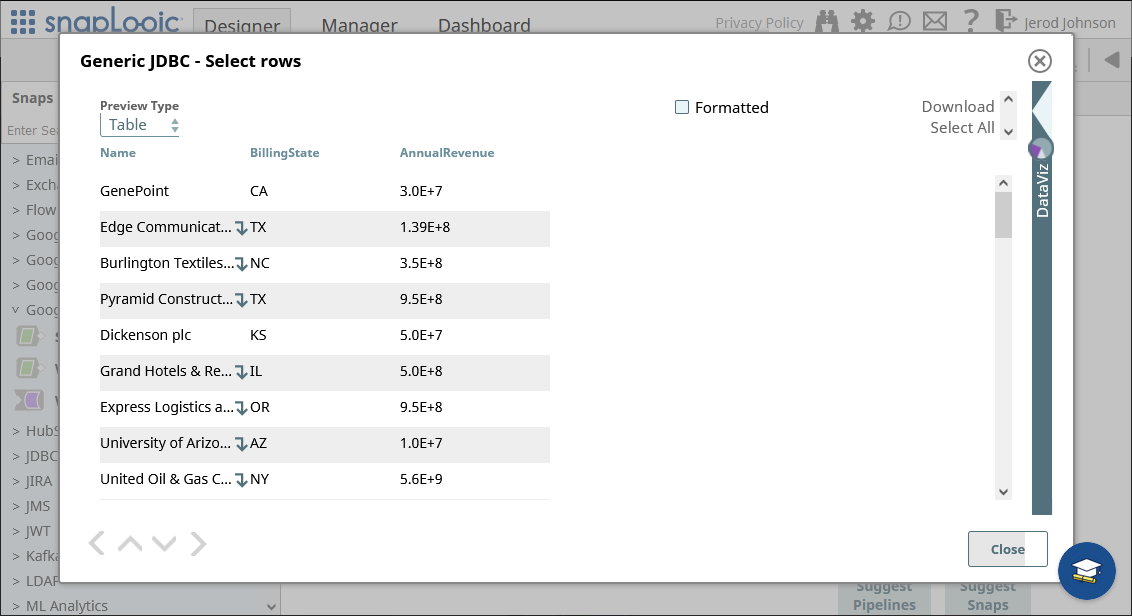
Piping Elasticsearch Data to External Services
For this article, we will load data in a Google Spreadsheet. You can use any of the supported snaps, or even use a Generic JDBC snap with another CData JDBC Driver, to move data into an external service.
- Start by dropping a "Worksheet Writer" snap onto the end of the "Generic JDBC - Select" snap.
- Add an account to connect to Google Sheets
![Connecting to Google]()
- Configure the Worksheet Writer snap to write your Elasticsearch data to a Google Spreadsheet
![Writing to a Google Spreadsheet]()
You can now execute the fully configured pipeline to extract data from Elasticsearch and push it into a Google Spreadsheet.
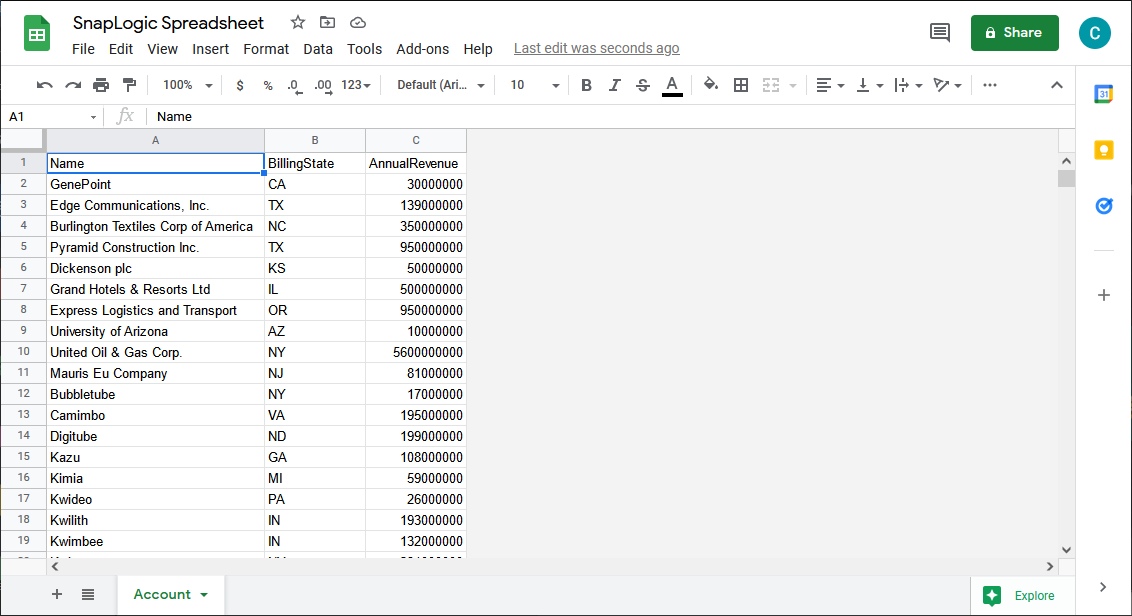
Piping External Data to Elasticsearch
As mentioned above, you can also use the JDBC Driver for Elasticsearch in SnapLogic to write data to Elasticsearch. Start by adding a Generic JDBC - Insert or Generic JDBC - Update snap to the dashboard.
- Select the existing "Account" (connection) or create a new one
- Configure the query:
- Set Schema name to "Elasticsearch"
- Set Table name to a table for Elasticsearch using the schema name, for example: "Elasticsearch"."Orders" (use the drop-down to see the full list of available tables)
![Configuring a INSERT snap (Salesforce is shown)]()
- Save the Generic JDBC - Insert/Update snap
At this point, you have configured a snap to write data to Elasticsearch, inserting new records or updating existing ones.
More Information & Free Trial
Using the CData JDBC Driver for Elasticsearch you can create a pipeline in SnapLogic for integrating Elasticsearch data with external services. For more information about connecting to Elasticsearch, check at our CData JDBC Driver for Elasticsearch page. Download a free, 30 day trial of the CData JDBC Driver for Elasticsearch and get started today.

